Study of the Digestate as an Innovative and Low-Cost Adsorbent for the Removal of Dyes in Wastewater
Abstract
:1. Introduction
2. Materials and Methods
2.1. Raw Materials
2.2. Batch Adsorption Experiments
2.3. Kinetic Models
2.4. Isotherm Models
3. Results and Discussion
3.1. Adsorption Ratio and Adsorption Capacity
3.2. Initial Dye pH and Concentrations
3.3. Adsorption Kinetics
3.4. Adsorption Isotherms
4. Conclusions
Author Contributions
Funding
Acknowledgments
Conflicts of Interest
References
- Deng, H.; Lu, J.; Li, G.; Zhang, G.; Wang, X. Adsorption of methylene blue on adsorbent materials produced from cotton stalk. Chem. Eng. J. 2011, 172, 326–334. [Google Scholar] [CrossRef]
- Gok, O.; Ozcan, A.S.; Ozcan, A. Adsorption behavior of a textile dye of Reactive Blue 19 from aqueous solutions onto modified bentonite. Appl. Surf. Sci. 2010, 256, 5439–5443. [Google Scholar] [CrossRef]
- Vakili, M.; Rafatullah, M.; Salamatinia, B.; Abdullah, A.Z.; Ibrahim, M.H.; Tan, K.B.; Gholami, Z.; Amouzgar, P. Application of chitosan and its derivatives as adsorbents for dye removal from water and wastewater: A review. Carbohydr. Polym. 2014, 113, 115–130. [Google Scholar] [CrossRef] [PubMed]
- Malash, G.F.; El-Khaiary, M.I. Methylene blue adsorption by the waste of Abu-Tartour phosphate rock. J. Colloid Interface Sci. 2010, 348, 537–545. [Google Scholar] [CrossRef] [PubMed]
- Pan, Y.; Wang, Y.; Zhou, A.; Wang, A.; Wu, Z.; Lv, L.; Li, X.; Zhang, K.; Zhu, T. Removal of azo dye in an up-flow membrane-less bioelectrochemical system integrated with bio-contact oxidation reactor. Chem. Eng. J. 2017, 326, 454–461. [Google Scholar] [CrossRef]
- Edison, T.N.J.I.; Lee, Y.R.; Sethuraman, M.G. Green synthesis of silver nanoparticles using Terminalia cuneata and its catalytic action in reduction of direct yellow-12 dye. Spectrochim. Acta A 2016, 161, 122–129. [Google Scholar] [CrossRef]
- De Gisi, S.; Lofrano, G.; Grassi, M.; Notarnicola, M. Characteristics and adsorption capacities of low-cost sorbents for wastewater treatment: A review. Sustain. Mater. Technol. 2016, 9, 10–40. [Google Scholar] [CrossRef] [Green Version]
- Kausar, A.; Iqbal, M.; Javed, A.; Aftab, K.; Nazli, Z.-i.-H.; Bhatti, H.N.; Nouren, S. Dyes adsorption using clay and modified clay: A review. J. Mol. Liq. 2018, 256, 395–407. [Google Scholar] [CrossRef]
- Ozcan, A.; Oncu, E.M.; Ozcan, A.S. Adsorption of acid blue 193 from aqueous solutions onto DEDMA-sepiolite. J. Hazard. Mater. 2006, 129, 244–252. [Google Scholar] [CrossRef]
- Berrazoum, A.; Marouf, R.; Ouadjenia, F.; Schott, J. Bioadsorption of a reactive dye from aqueous solution by municipal solid waste. Biotechnol. Rep. 2015, 7, 44–50. [Google Scholar] [CrossRef] [Green Version]
- Monteiro, A.; Jarrais, B.; Rocha, I.M.; Pereira, C.; Pereira, M.F.R.; Freire, C. Efficient immobilization of montmorillonite onto cotton textiles through their functionalization with organosilanes. Appl. Clay Sci. 2014, 101, 304–314. [Google Scholar] [CrossRef]
- Zhou, L.; Zhou, H.; Hu, Y.; Yan, S.; Yang, J. Adsorption removal of cationic dyes from aqueous solutions using ceramic adsorbents prepared from industrial waste coal gangue. J. Environ. Manag. 2019, 234, 245–252. [Google Scholar] [CrossRef] [PubMed]
- Njoku, V.O.; Foo, K.Y.; Asif, M.; Hameed, B.H. Preparation of activated carbons from rambutan (Nephelium lappaceum) peel by microwave-induced KOH activation for acid yellow 17 dye adsorption. Chem. Eng. J. 2014, 250, 198–204. [Google Scholar] [CrossRef]
- Garg, A.; Mainrai, M.; Bulasara, V.K.; Barman, S. Experimental investigation on adsorption of amido black 10B dye onto zeolite synthesized from fly ash. Chem. Eng. Commun. 2015, 202, 123–130. [Google Scholar] [CrossRef]
- Qiu, M.; Qian, C.; Xu, J.; Wu, J.; Wang, G. Studies on the adsorption of dyes into clinoptilolite. Desalination 2009, 243, 286–292. [Google Scholar] [CrossRef]
- Hosseini Koupaie, E.; Eskicioglu, C. Health risk assessment of heavy metals through the consumption of food crops fertilized by biosolids: A probabilistic-based analysis. J. Hazard. Mater. 2015, 300, 855–865. [Google Scholar] [CrossRef]
- Sakar, H.; Celik, I.; Balcik-Canbolat, C.; Keskinler, B.; Karagunduz, A. Ammonium removal and recovery from real digestate wastewater by a modified operational method of membrane capacitive deionization unit. J. Clean. Prod. 2019, 215, 1415–1423. [Google Scholar] [CrossRef]
- Hu, Q.; Xu, Z.; Qiao, S.; Haghseresht, F.; Wilson, M.; Lu, G.Q. A novel color removal adsorbent from heterocoagulation of cationic and anionic clays. J. Colloid Interface Sci. 2007, 308, 191–199. [Google Scholar] [CrossRef]
- Hong, S.; Ratpukdi, T.; Sungthong, B.; Sivaguru, J.; Khan, E. A sustainable solution for removal of glutaraldehyde in saline water with visible light photocatalysis. Chemosphere 2019, 220, 1083–1090. [Google Scholar] [CrossRef]
- Kheirabadi, M.; Samadi, M.; Asadian, E.; Zhou, Y.; Dong, C.; Zhang, J.; Moshfegh, A.Z. Well-designed Ag/ZnO/3D graphene structure for dye removal: Adsorption, photocatalysis and physical separation capabilities. J. Colloid Interface Sci. 2019, 537, 66–78. [Google Scholar] [CrossRef]
- Sharma, P.; Borah, D.J.; Das, P.; Das, M.R. Cationic and anionic dye removal from aqueous solution using montmorillonite clay: Evaluation of adsorption parameters and mechanism. Desalin. Water Treat. 2016, 57, 8372–8388. [Google Scholar] [CrossRef]
- Sözüdoğru, O.; Fil, B.A.; Boncukcuoğlu, R.; Aladağ, E.; Kul, S. Adsorptive removal of cationic (BY2) dye from aqueous solutions onto Turkish clay: Isotherm, kinetic, and thermodynamic analysis. Particul. Sci. Technol. 2016, 34, 103–111. [Google Scholar] [CrossRef]
- Fu, D.; Chen, Z.; Xia, D.; Shen, L.; Wang, Y.; Li, Q. A novel solid digestate-derived biochar-Cu NP composite activating H2O2 system for simultaneous adsorption and degradation of tetracycline. Environ. Pollut. 2017, 221, 301–310. [Google Scholar] [CrossRef] [PubMed]
- Yin, J.; Pei, M.; He, Y.; Du, Y.; Guo, W.; Wang, L. Hydrothermal and activated synthesis of adsorbent montmorillonite supported porous carbon nanospheres for removal of methylene blue from waste water. RSC Adv. 2015, 5, 89839–89847. [Google Scholar] [CrossRef]
- Zemaitaitiene, R.J.; Zliobaite, E.; Klimaviciute, R.; Zemaitaitis, A. The role of anionic substances in removal of textile dyes from solutions using cationic flocculant. Colloids Surf. Physicochem. Eng. Aspects 2003, 214, 37–47. [Google Scholar] [CrossRef]
- Makhoukhi, B.; Djab, M.; Amine Didi, M. Adsorption of Telon dyes onto bis-imidazolium modified bentonite in aqueous solutions. J. Environ. Chem. Eng. 2015, 3, 1384–1392. [Google Scholar] [CrossRef]
- Yang, Z.; Li, M.; Yu, M.; Huang, J.; Xu, H.; Zhou, Y.; Song, P.; Xu, R. A novel approach for methylene blue removal by calcium dodecyl sulfate enhanced precipitation and microbial flocculant GA1 flocculation. Chem. Eng. J. 2016, 303, 1–13. [Google Scholar] [CrossRef]
- Pirozzi, C.; Pontoni, L.; Fabbricino, M.; Bogush, A.; Campos, L.C. Effect of organic matter release from natural cork used on bisphenol a removal from aqueous solution. J. Clean. Prod. 2020, 244, 118675. [Google Scholar] [CrossRef]
- Fan, L.; Chen, Y.; Wang, L.; Jiang, W. Adsorption of Pb(II) Ions from aqueous solutions by pyrolusite-modified activated carbon prepared from sewage sludge. Adsorpt. Sci. Technol. 2011, 29, 495–506. [Google Scholar] [CrossRef]
- Fogg, A.G.; Rahim, A.; Yusoff, H.M.; Ahmad, R. Cathodic stripping voltammetry of copper-complexed reactive dyes at a hanging mercury drop electrode: Reactive violet 5. Talanta 1997, 44, 125–129. [Google Scholar] [CrossRef]
- Jiang, R.; Zhu, H.; Li, X.; Xiao, L. Visible light photocatalytic decolourization of C. I. Acid Red 66 by chitosan capped CdS composite nanoparticles. Chem. Eng. J. 2009, 152, 537–542. [Google Scholar] [CrossRef]
- Melo, R.P.F.; Barros Neto, E.L.; Moura, M.C.P.A.; Castro Dantas, T.N.; Dantas Neto, A.A.; Oliveira, H.N.M. Removal of direct Yellow 27 dye using animal fat and vegetable oil-based surfactant. J. Water Process Eng. 2015, 7, 196–202. [Google Scholar] [CrossRef]
- Wang, W.; Bai, H.; Zhao, Y.; Kang, S.; Yi, H.; Zhang, T.; Song, S. Synthesis of chitosan cross-linked 3D network-structured hydrogel for methylene blue removal. Int. J. Biol. Macromol. 2019, 141, 98–107. [Google Scholar] [CrossRef]
- Doke, K.M.; Khan, E.M. Equilibrium, kinetic and diffusion mechanism of Cr(VI) adsorption onto activated carbon derived from wood apple shell. Arab. J. Chem. 2017, 10, S252–S260. [Google Scholar] [CrossRef] [Green Version]
- Islam, M.A.; Ali, I.; Karim, S.M.A.; Hossain Firoz, M.S.; Chowdhury, A.-N.; Morton, D.W.; Angove, M.J. Removal of dye from polluted water using novel nano manganese oxide-based materials. J. Water Process Eng. 2019, 32, 100911. [Google Scholar] [CrossRef]
- Agarwal, S.; Tyagi, I.; Gupta, V.K.; Ghasemi, N.; Shahivand, M.; Ghasemi, M. Kinetics, equilibrium studies and thermodynamics of methylene blue adsorption on Ephedra strobilacea saw dust and modified using phosphoric acid and zinc chloride. J. Mol. Liq. 2016, 218, 208–218. [Google Scholar] [CrossRef]
- Postai, D.L.; Demarchi, C.A.; Zanatta, F.; Melo, D.C.C.; Rodrigues, C.A. Adsorption of rhodamine B and methylene blue dyes using waste of seeds of Aleurites Moluccana, a low cost adsorbent. Alex. Eng. J. 2016, 55, 1713–1723. [Google Scholar] [CrossRef] [Green Version]
- Hammed, A.K.; Dewayanto, N.; Du, D.; Ab Rahim, M.H.; Nordin, M.R. Novel modified ZSM-5 as an efficient adsorbent for methylene blue removal. J. Environ. Chem. Eng. 2016, 4, 2607–2616. [Google Scholar] [CrossRef]
- Fosso-Kankeu, E.; Mittal, H.; Mishra, S.B.; Mishra, A.K. Gum ghatti and acrylic acid based biodegradable hydrogels for the effective adsorption of cationic dyes. J. Ind. Eng. Chem. 2015, 22, 171–178. [Google Scholar] [CrossRef]
- Moradi, M.; Ghanbari, F.; Manshouri, M.; Angali, K.A. Photocatalytic degradation of azo dye using nano-ZrO 2/UV/Persulfate: Response surface modeling and optimization. Korean J. Chem. Eng. 2016, 33, 539–546. [Google Scholar] [CrossRef]
- Anastopoulos, I.; Kyzas, G.Z. Agricultural peels for dye adsorption: A review of recent literature. J. Mol. Liq. 2014, 200, 381–389. [Google Scholar] [CrossRef]
- Qian, J.; Shen, M.; Wang, P.; Wang, C.; Li, K.; Liu, J.; Lu, B.; Tian, X. Perfluorooctane sulfonate adsorption on powder activated carbon: Effect of phosphate (P) competition, pH, and temperature. Chemosphere 2017, 182, 215–222. [Google Scholar] [CrossRef] [PubMed]
- Yagub, M.T.; Sen, T.K.; Afroze, S.; Ang, H.M. Dye and its removal from aqueous solution by adsorption: A review. Adv. Colloid Interface Sci. 2014, 209, 172–184. [Google Scholar] [CrossRef] [PubMed]
- Domingues, V.; Alves, A.; Cabral, M.; Delerue-Matos, C. Sorption behaviour of bifenthrin on cork. J. Chromatogr. 2005, 1069, 127–132. [Google Scholar] [CrossRef] [Green Version]
- Brar, S.K.; Wangoo, N.; Sharma, R.K. Enhanced and selective adsorption of cationic dyes using novel biocompatible self-assembled peptide fibrils. J. Environ. Manag. 2020, 255, 109804. [Google Scholar] [CrossRef]
- Fomina, M.; Gadd, G.M. Biosorption: Current perspectives on concept, definition and application. Bioresour. Technol. 2014, 160, 3–14. [Google Scholar] [CrossRef]
- Wang, J.; Chen, C. Biosorbents for heavy metals removal and their future. Biotechnol. Adv. 2009, 27, 195–226. [Google Scholar] [CrossRef]
- Jain, S.N.; Tamboli, S.R.; Sutar, D.S.; Jadhav, S.R.; Marathe, J.V.; Shaikh, A.A.; Prajapati, A.A. Batch and continuous studies for adsorption of anionic dye onto waste tea residue: Kinetic, equilibrium, breakthrough and reusability studies. J. Clean. Prod. 2020, 252, 119778. [Google Scholar] [CrossRef]
- Kizito, S.; Wu, S.; Kipkemoi Kirui, W.; Lei, M.; Lu, Q.; Bah, H.; Dong, R. Evaluation of slow pyrolyzed wood and rice husks biochar for adsorption of ammonium nitrogen from piggery manure anaerobic digestate slurry. Sci. Total Environ. 2015, 505, 102–112. [Google Scholar] [CrossRef]
- Ma, T.; Wu, Y.; Liu, N.; Wu, Y. Hydrolyzed polyacrylamide modified diatomite waste as a novel adsorbent for organic dye removal: Adsorption performance and mechanism studies. Polyhedron 2020, 175, 114227. [Google Scholar] [CrossRef]
- Isah, A.U.; Abdulraheem, G.; Bala, S.; Muhammad, S.; Abdullahi, M. Kinetics, equilibrium and thermodynamics studies of C.I. Reactive Blue 19 dye adsorption on coconut shell based activated carbon. Int. Biodeterior. Biodegrad. 2015, 102, 265–273. [Google Scholar] [CrossRef]
- Galán, J.; Rodríguez, A.; Gómez, J.M.; Allen, S.J.; Walker, G.M. Reactive dye adsorption onto a novel mesoporous carbon. Chem. Eng. J. 2013, 219, 62–68. [Google Scholar] [CrossRef]
- Yao, S.; Wang, M.; Liu, J.; Tang, S.; Chen, H.; Guo, T.; Yang, G.; Chen, Y. Removal of phosphate from aqueous solution by sewage sludge-based activated carbon loaded with pyrolusite. J. Water Reuse Desalin. 2017, 8, 192–201. [Google Scholar] [CrossRef] [Green Version]
- El Boundati, Y.; Ziat, K.; Naji, A.; Saidi, M. Generalized fractal-like adsorption kinetic models: Application to adsorption of copper on Argan nut shell. J. Mol. Liq. 2019, 276, 15–26. [Google Scholar] [CrossRef]
- Guo, X.; Wang, J. A general kinetic model for adsorption: Theoretical analysis and modeling. J. Mol. Liq. 2019, 288, 111100. [Google Scholar] [CrossRef]
- Rangabhashiyam, S.; Anu, N.; Selvaraju, N. Sequestration of dye from textile industry wastewater using agricultural waste products as adsorbents. J. Environ. Chem. Eng. 2013, 1, 629–641. [Google Scholar] [CrossRef]
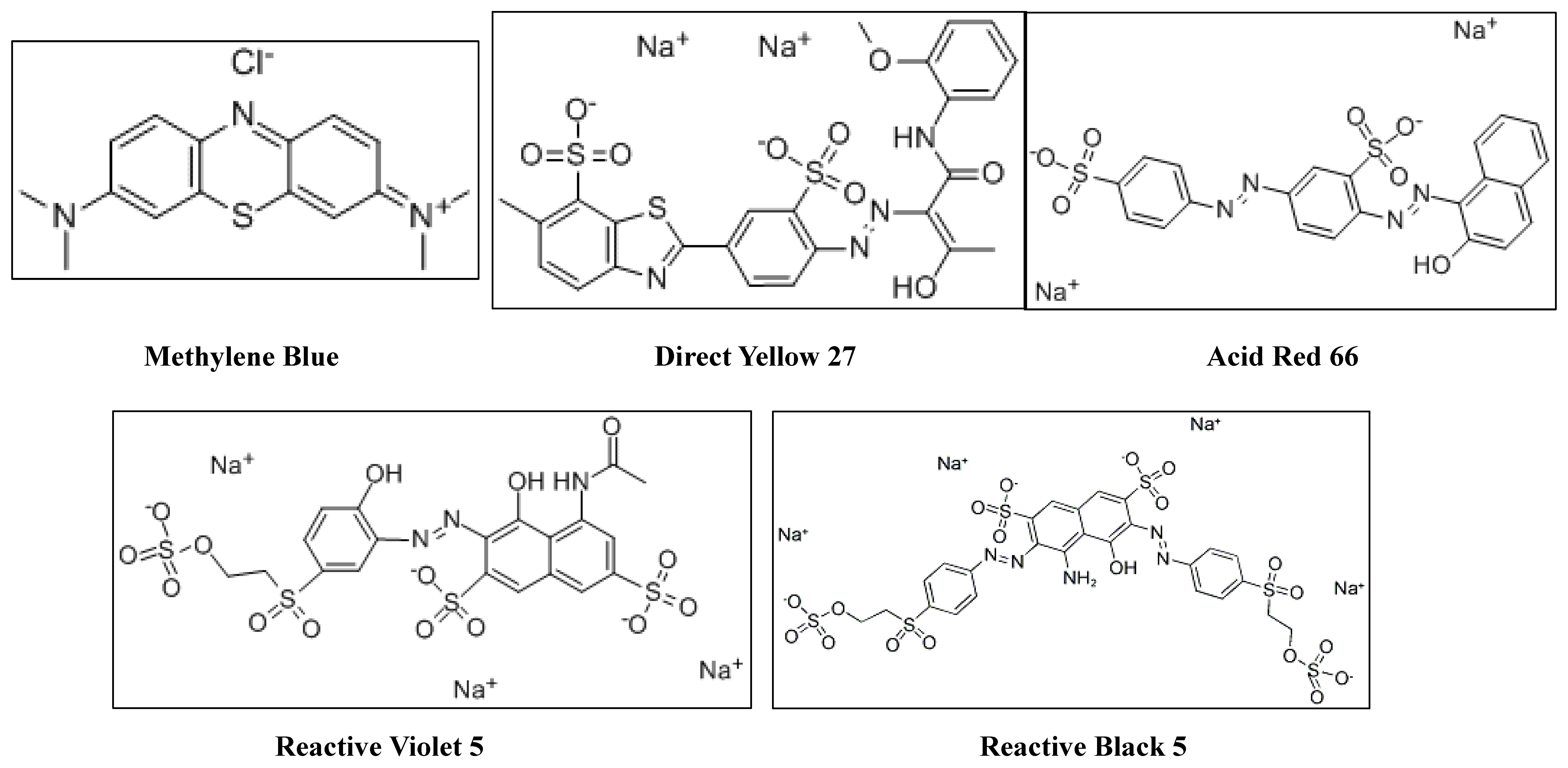
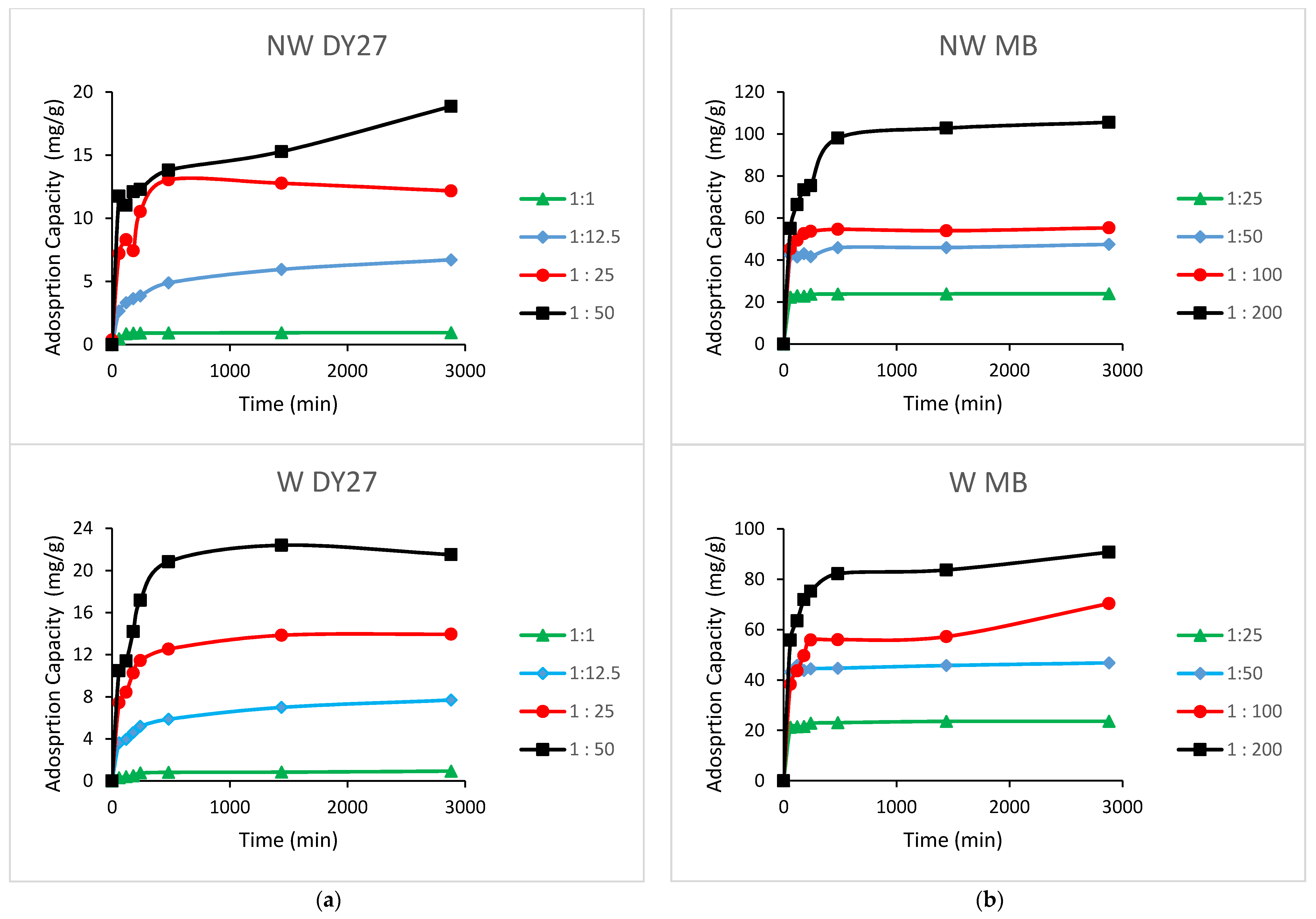
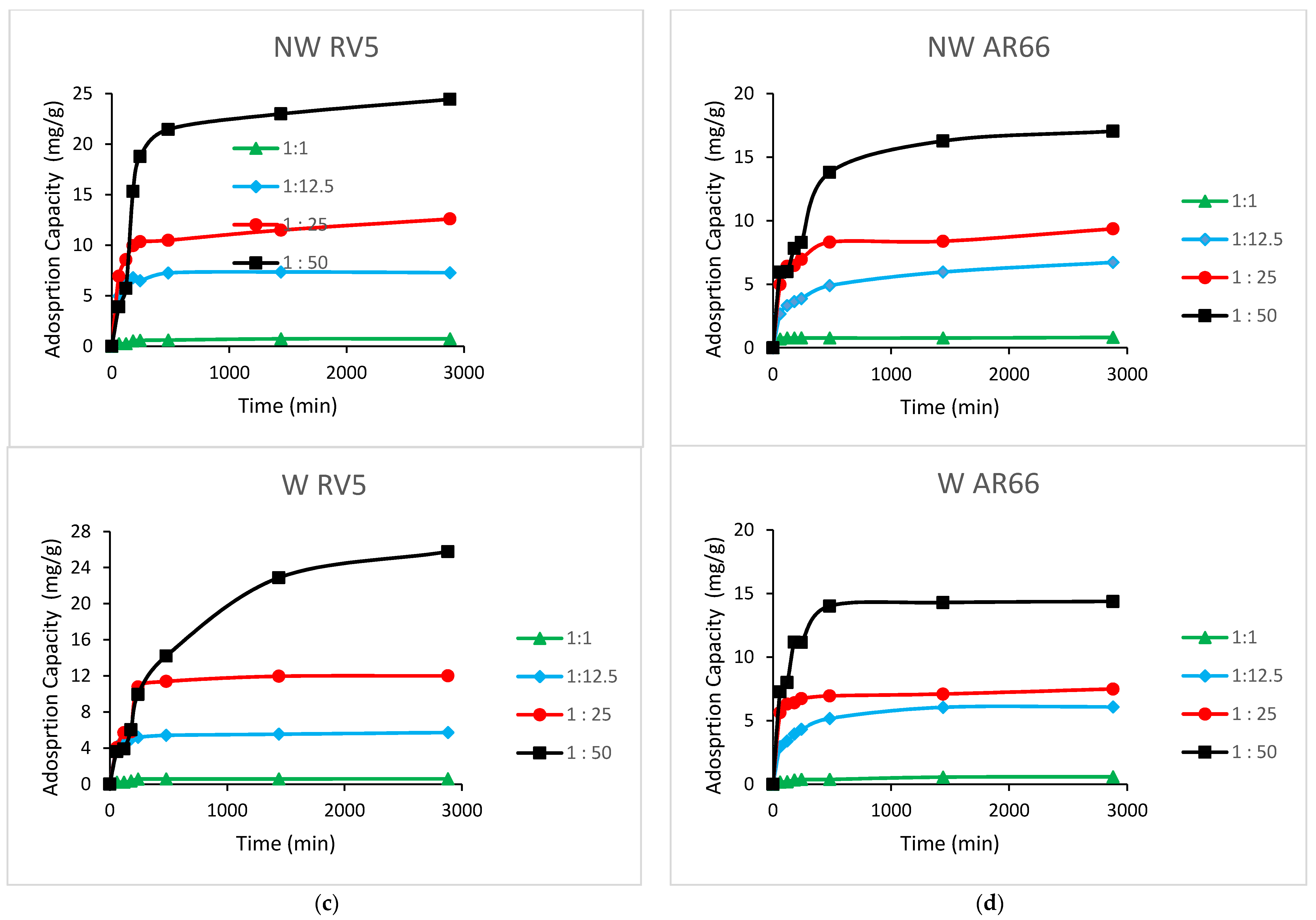
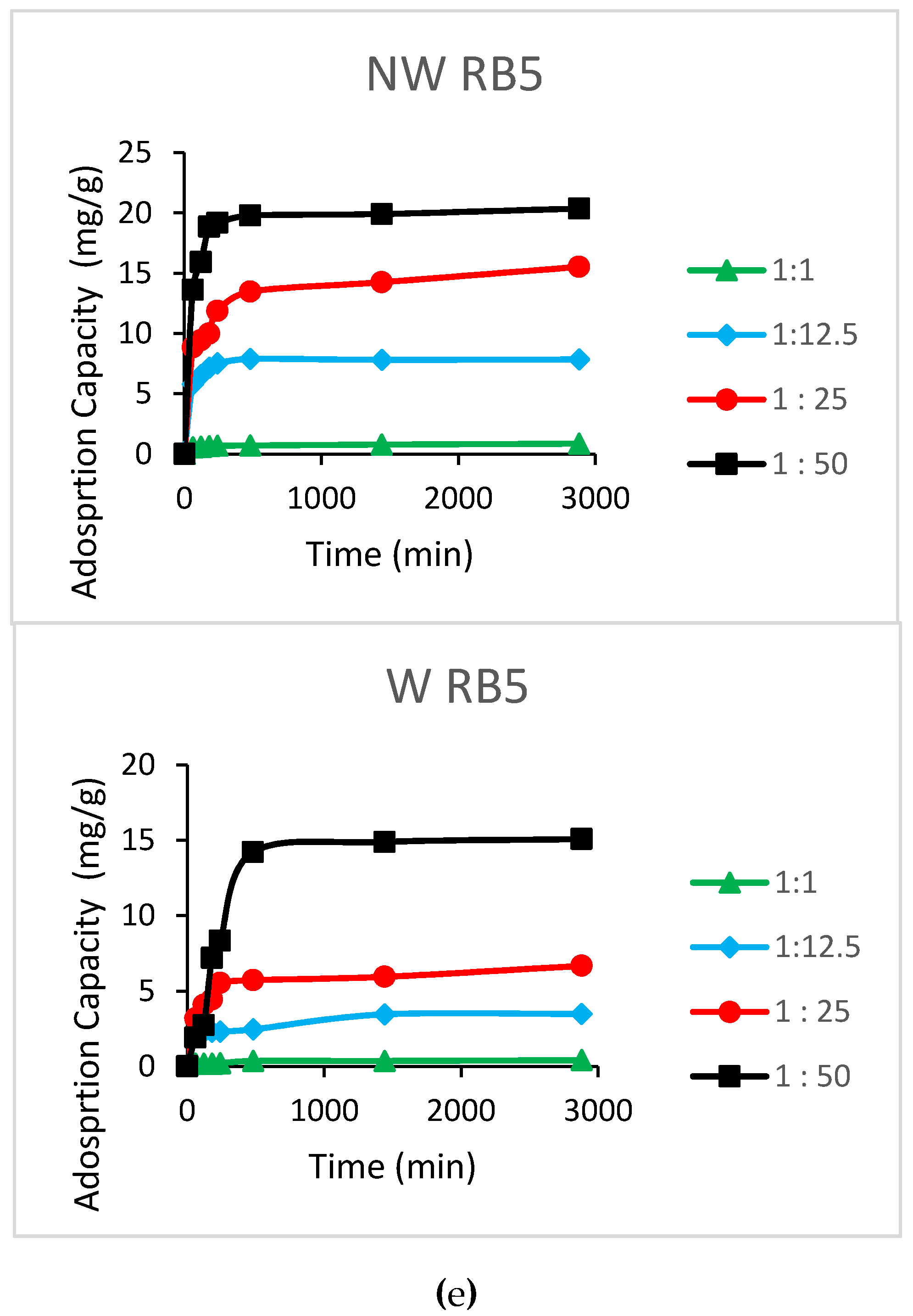
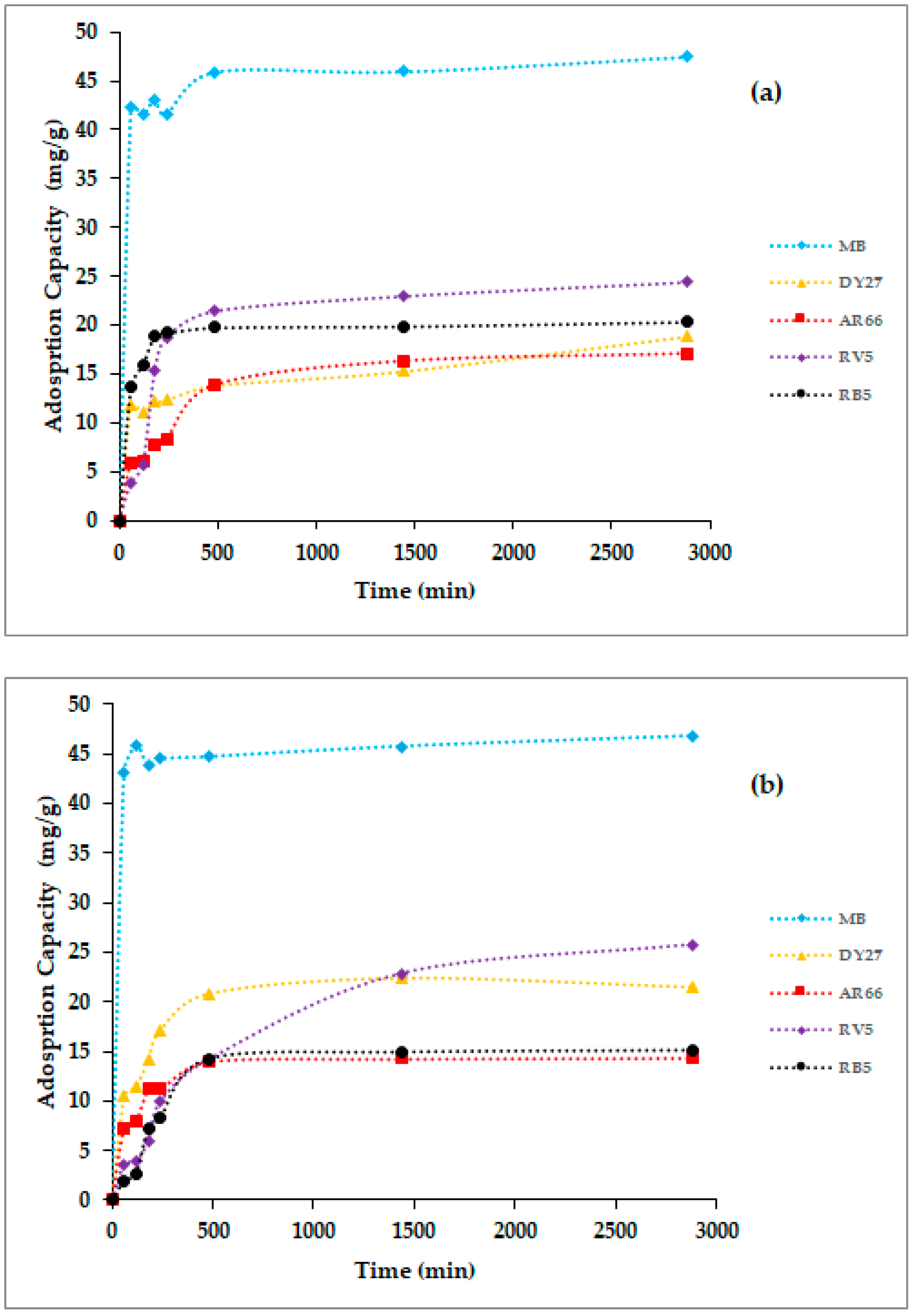
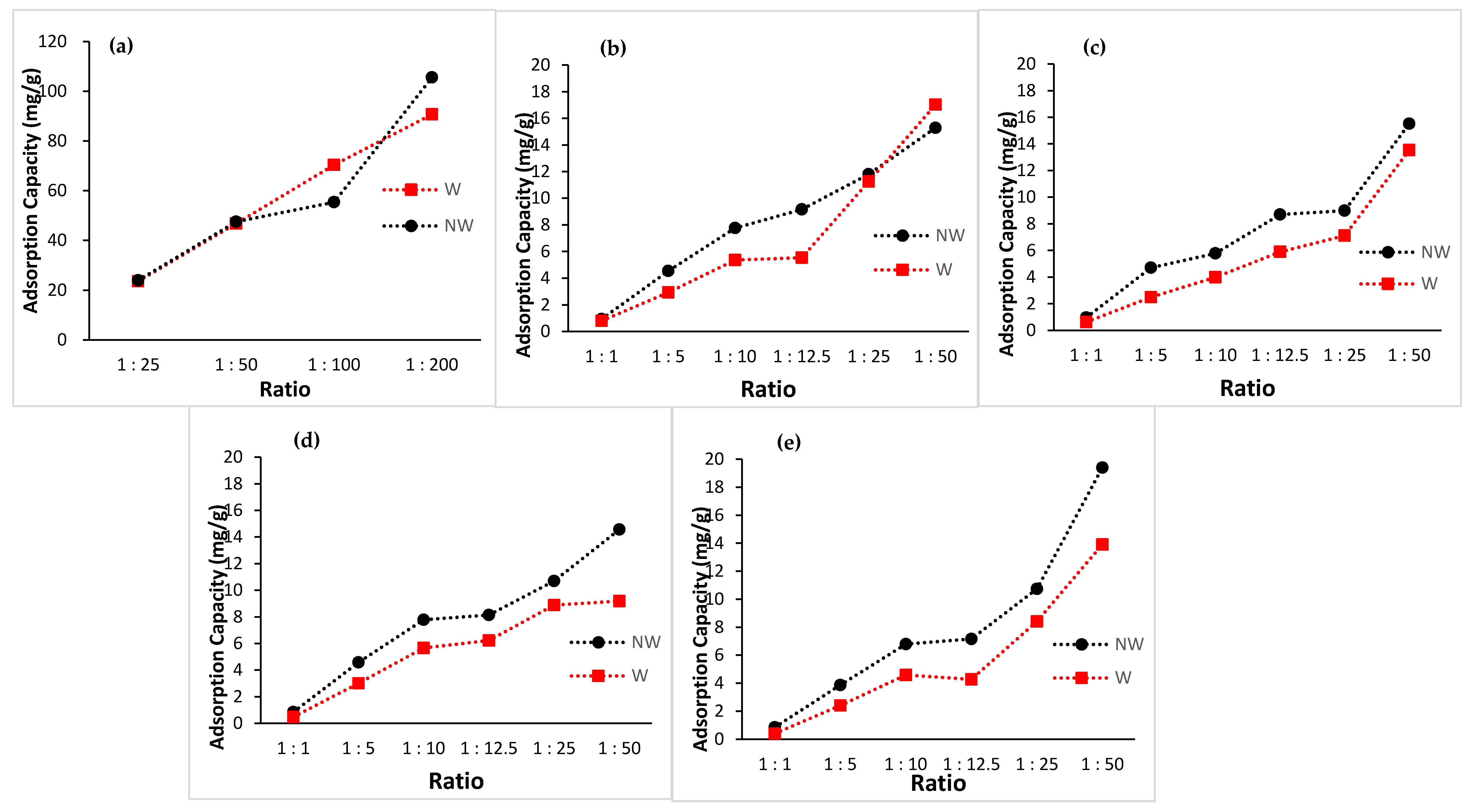
| Adsorbents | qe(exp) (mg/g) | Pseudo-First-Order | Pseudo-Second-Order | Intra-Particle Diffusion | |||||||
|---|---|---|---|---|---|---|---|---|---|---|---|
| qe(cal) (mg/g) | k1 (1/h) | R12 | ∆q (%) | qe(cal) (mg/g) | k2 (g/mg·h) | R22 | ∆q (%) | kp [mg/(g·min1/2)] | R32 | ||
| MB nw 1:200 | 102.85 | 105.59 | 0.0023 | 0.8542 | 1.5381 | 107.53 | 0.0002 | 0.9991 | 2.6254 | 1.0334 | 0.7735 |
| Yellow nw 1:50 | 18.86 | 20.00 | 0.0007 | 0.8225 | 3.4722 | 18.51 | 0.0005 | 0.9780 | 1.0617 | 0.1448 | 0.8413 |
| Red nw 1: 50 | 16.27 | 17.03 | 0.0010 | 0.7534 | 2.6969 | 17.98 | 0.0003 | 0.9924 | 6.0879 | 0.2657 | 0.8542 |
| Violet nw 1: 50 | 24.42 | 24.50 | 0.0019 | 0.9410 | 0.1757 | 26.04 | 0.0002 | 0.9812 | 3.8198 | 0.385 | 0.6118 |
| Black nw 1:50 | 20.35 | 19.90 | 0.0020 | 0.5324 | 1.2735 | 20.44 | 0.0024 | 0.9998 | 0.2655 | 0.1026 | 0.4749 |
| MB w 1:200 | 83.65 | 90.70 | 0.0013 | 0.5654 | 4.8645 | 90.91 | 0.0002 | 0.9986 | 5.0102 | 0.6282 | 0.7565 |
| Yellow w 1:50 | 22.40 | 21.50 | 0.0010 | 0.6288 | 2.3115 | 22.88 | 0.0006 | 0.9986 | 1.2432 | 0.2492 | 0.7202 |
| Red w 1: 50 | 14.37 | 14.28 | 0.0034 | 0.8608 | 0.3614 | 14.66 | 0.0013 | 0.9990 | 1.1365 | 0.1416 | 0.6430 |
| Violet w 1: 50 | 25.75 | 25.80 | 0.0021 | 0.9765 | 0.0993 | 29.94 | 0.0001 | 0.9470 | 9.3800 | 0.5205 | 0.9398 |
| Black w 1:50 | 15.08 | 15.10 | 0.0023 | 0.9322 | 0.0747 | 16.80 | 0.0002 | 0.9619 | 6.6088 | 0.2807 | 0.6947 |
| Dye | qe (mg/g) | Langmuir Isotherm | Freundlich Isotherm | Sips Isotherm | ||||||||
|---|---|---|---|---|---|---|---|---|---|---|---|---|
| qm (mg/g) | KL (L/mg) | RL | R2 | KF (mg/g(L/mg)1/n) | 1/n (mmol/g) | R2 | n | qm (mg/g) | KLF (L/mg) | R2 | ||
| Yellow NW | 15.2876 | 22.7790 | 0.0493 | 0.2884 | 0.9452 | 22.6358 | 2.5770 | 0.9228 | 0.3880 | 18.1818 | 0.1152 | 0.8408 |
| Yellow W | 17.0318 | 1.8850 | 0.0289 | 0.4088 | 0.8905 | 1.8055 | 0.9870 | 0.7801 | 1.0132 | 1.9968 | 0.0273 | 0.9032 |
| Black NW | 19.4047 | 5.5402 | 0.0262 | 0.4331 | 0.5105 | 29.3833 | 1.8085 | 0.9234 | 0.5529 | 5.6022 | 0.1093 | 0.7886 |
| Black W | 16.8394 | 0.8210 | 0.0215 | 0.4814 | 0.0506 | 19.9950 | 2.8271 | 0.1300 | 0.3537 | 1.2073 | 0.2309 | 0.1652 |
| Red NW | 15.5198 | 13.0208 | 0.0839 | 0.1925 | 0.5439 | 1.5184 | 4.0241 | 0.6292 | 1.7486 | 10.8578 | 0.0230 | 0.7256 |
| Red W | 13.5397 | 0.7997 | 0.0272 | 0.4240 | 0.6622 | 17.1023 | 0.5719 | 0.8692 | 0.2485 | 0.1361 | 0.4125 | 0.7269 |
| Violet NW | 14.5638 | 25.7069 | 0.0105 | 0.6568 | 0.0305 | 1.4292 | 1.4815 | 0.4285 | 1.2267 | 16.4474 | 0.0411 | 0.7575 |
| Violet W | 9.1926 | 3.0497 | 0.0151 | 0.5703 | 0.0161 | 32.4190 | 0.8152 | 0.1231 | 0.6750 | 6.4977 | 0.0509 | 0.2682 |
| MB NW | 105.5900 | 135.1351 | 0.1682 | 0.1063 | 0.9264 | 24.4118 | 1.9312 | 0.7240 | 0.5178 | 196.0784 | 0.2417 | 0.7715 |
| MB W | 90.6980 | 116.2791 | 0.1203 | 0.1426 | 0.9465 | 19.6562 | 2.1299 | 0.8092 | 0.4695 | 188.6792 | 0.1834 | 0.9120 |
© 2020 by the authors. Licensee MDPI, Basel, Switzerland. This article is an open access article distributed under the terms and conditions of the Creative Commons Attribution (CC BY) license (http://creativecommons.org/licenses/by/4.0/).
Share and Cite
Yao, S.; Fabbricino, M.; Race, M.; Ferraro, A.; Pontoni, L.; Aimone, O.; Chen, Y. Study of the Digestate as an Innovative and Low-Cost Adsorbent for the Removal of Dyes in Wastewater. Processes 2020, 8, 852. https://doi.org/10.3390/pr8070852
Yao S, Fabbricino M, Race M, Ferraro A, Pontoni L, Aimone O, Chen Y. Study of the Digestate as an Innovative and Low-Cost Adsorbent for the Removal of Dyes in Wastewater. Processes. 2020; 8(7):852. https://doi.org/10.3390/pr8070852
Chicago/Turabian StyleYao, Sicong, Massimiliano Fabbricino, Marco Race, Alberto Ferraro, Ludovico Pontoni, Oriella Aimone, and Yao Chen. 2020. "Study of the Digestate as an Innovative and Low-Cost Adsorbent for the Removal of Dyes in Wastewater" Processes 8, no. 7: 852. https://doi.org/10.3390/pr8070852





